Effects of Accelerated Ageing by Humidity and Heat Cycles on the Quality of Bamboo
Abstract
:1. Introduction
2. Materials and Methods
2.1. Materials
2.2. Experimental Procedures
2.2.1. Humidity and Heat Cycle Ageing Procedure
2.2.2. Natural Ageing Procedure in the Field
2.3. Characterizations
3. Results
3.1. Color Change of Bamboo Cortex and Pith during Ageing Period
3.2. Effect of Humid Heat Cycle on the Weight and Density of Bamboo during Accelerated Ageing
3.3. Effect on Cellulose Crystallinity during Humid Heat Cycle Ageing of Bamboo
3.4. Effect of Bamboo on FT-IR during Humid Heat Cycling and Natural Indoor Ageing
3.5. Effect of Bamboo on Axial Compressive Properties during Humid Heat Cycling and Natural Indoor Ageing
3.6. Effect of Bamboo on Axial Compression Properties during Humid Heat Cycling and Natural Indoor Ageing
4. Conclusions
Author Contributions
Funding
Institutional Review Board Statement
Informed Consent Statement
Data Availability Statement
Acknowledgments
Conflicts of Interest
References
- Mohan, N.; Dash, S.P.; Boby, N.M.; Shetty, D. Study of bamboo as a building material—Construction & preservation techniques and its sustainability. Mater. Today Proc. 2022, 60, 100–114. [Google Scholar]
- Xu, P.; Zhu, J.; Li, H.; Wei, Y.; Xiong, Z.; Xu, X. Are bamboo construction materials environmentally friendly? A life cycle environmental impact analysis. Environ. Impact Assess. Rev. 2022, 96, 106853. [Google Scholar] [CrossRef]
- Kumar, D.; Mandal, A. Review on manufacturing and fundamental aspects of laminated bamboo products for structural applications. Constr. Build. Mater. 2022, 348, 128691. [Google Scholar] [CrossRef]
- Sun, X.; He, M.; Li, Z. Novel engineered wood and bamboo composites for structural applications: State-of-art of manufacturing technology and mechanical performance evaluation. Constr. Build. Mater. 2020, 249, 118751. [Google Scholar] [CrossRef]
- Liu, K.W.; Xu, Q.F.; Wang, G.; Chen, F.M.; Leng, Y.B.; Yang, J.; Harries, K.A. Research and Development Status of Different Types of Bamboo Structures. In Contemporary Bamboo Architecture in China; Liu, K.W., Xu, Q.F., Wang, G., Chen, F.M., Leng, Y.B., Yang, J., Harries, K.A., Eds.; Springer: Singapore, 2022; pp. 31–57. [Google Scholar]
- Van Der Lugt, P.; Van den Dobbelsteen, A.; Abrahams, R. Bamboo as a building material alternative for Western Europe? A study of the environmental performance, costs and bottlenecks of the use of bamboo (products) in Western Europe. J. Bamboo Ratt. 2003, 2, 205–223. [Google Scholar] [CrossRef]
- Maxwell, A.S.; Broughton, W.R.; Dean, G.; Sims, G.D. Review of Accelerated Ageing Methods and Lifetime Prediction Techniques for Polymeric Materials; NPL Report DEPC MPR; NPL: Phoenix, AZ, USA, 2005. [Google Scholar]
- Crossman, F.W.; Mauri, R.E.; Warren, W.J. Hygrothermal Damage Mechanisms in Graphite-Epoxy Composites; Lockheed Missiles and Space Co Inc.: Palo Alto, CA, USA, 1980. [Google Scholar]
- Patel, S.R.; Case, S.W. Durability of hygrothermally aged graphite/epoxy woven composite under combined hygrothermal conditions. Int. J. Fatigue 2002, 24, 1295–1301. [Google Scholar] [CrossRef]
- Chung, C.T.; Sun, I.; Chang, Y. Modeling Creep in Thermoplastic Composites. J. Compos. Mater. 1993, 27, 1009–1029. [Google Scholar] [CrossRef]
- Miller, S.G.; Roberts, G.D.; Bail, J.L.; Kohlman, L.W.; Binienda, W.K. Effects of hygrothermal cycling on the chemical, thermal, and mechanical properties of 862/W epoxy resin. High Perform. Polym. 2012, 24, 470–477. [Google Scholar] [CrossRef]
- Tian, W.; Hodgkin, J. Long-Term Aging in a Commercial Aerospace Composite Sample: Chemical and Physical Changes. J. Appl. Polym. Sci. 2010, 115, 2981–2985. [Google Scholar] [CrossRef]
- Dao, B.; Hodgkin, J.; Krstina, J.; Mardel, J.; Tian, W. Accelerated aging versus realistic aging in aerospace composite materials. I. The chemistry of thermal aging in a low-temperature-cure epoxy composite. J. Appl. Polym. Sci. 2006, 102, 4291–4303. [Google Scholar] [CrossRef]
- Jia, H.; Chen, H.; Sheng, Y.; Meng, J.; Cui, S.; Kim, Y.R.; Huang, S. Qin, H. Effect of laboratory aging on the stiffness and fatigue cracking of asphalt mixture containing bamboo fiber. J. Clean. Prod. 2022, 333, 130120. [Google Scholar] [CrossRef]
- Zhang, J.Y.; Zeng, Q.Y.; Yu, T.X.; Kim, J.K. Residual properties of reformed bamboo/aluminium laminates after hygrothermal aging. Compos. Sci. Technol. 2001, 61, 1041–1048. [Google Scholar] [CrossRef]
- Turku, I.; Kärki, T.; Puurtinen, A. Durability of wood plastic composites manufactured from recycled plastic. Heliyon 2018, 4, e00559. [Google Scholar] [CrossRef]
- Ma, X.; Luo, Z.; Ji, C.H.; Cai, L.; Fei, B. Flexural creep behaviors of bamboo subjected to different gradient variation directions and relative humidity. Ind. Crops Prod. 2022, 179, 114679. [Google Scholar] [CrossRef]
- Kojima, Y.; Suzuki, S. Evaluation of wood-based panel durability using bending properties after accelerated aging treatments. J. Wood Sci. 2011, 57, 126–133. [Google Scholar]
- Tomak, E.D.; Topaloglu, E.; Ay, N.; Yildiz, U.C. Effect of accelerated aging on some physical and mechanical properties of bamboo. Wood Sci. Technol. 2012, 46, 905–918. [Google Scholar] [CrossRef]
- Wang, L.L.; Li, W. A study of thermal destratification for large warehouse energy savings. Energy Build. 2017, 153, 126–135. [Google Scholar]
- Lee, C.H.; Yang, T.H.; Cheng, Y.W.; Lee, C.J. Effects of thermal modification on the surface and chemical properties of moso bamboo. Constr. Build. Mater. 2018, 178, 59–71. [Google Scholar]
- Huang, C.; Zhan, Y.; Cheng, J.; Wang, J.; Meng, X.; Fang, G.; Ragauskas, A.J. The bamboo delignification saturation point in alkaline hydrogen peroxide pretreatment and its association with enzymatic hydrolysis. Bioresour. Technol. 2022, 359, 127462. [Google Scholar] [CrossRef]
- Qisheng, Z.; Shenxue, J.; Yongyu, T. Industrial Utilization on Bamboo; International Network for Bamboo and Rattan: Beijing, China, 2002.
- Huang, Z.; Sun, Y.; Musso, F. Experimental study on bamboo hygrothermal properties and the impact of bamboo-based panel process. Constr. Build. Mater. 2017, 155, 1112–1125. [Google Scholar] [CrossRef]
- An, X. Microfibril Orientations and Ultrastructures of Fibers Wall from Moso Bamboo; Chinese Academy of Forestry: Beijing, China, 2016. [Google Scholar]
- Rowell, R.M. Handbook of Wood Chemistry and Wood Composites; CRC Press: Boca Raton, FL, USA, 2005. [Google Scholar]
- Stokke, D.D.; Wu, Q.; Han, G. Introduction to Wood and Natural Fiber Composites; John Wiley & Sons: Hoboken, NJ, USA, 2013. [Google Scholar]
- Sweygers, N.; Depuydt, D.E.C.; Eyley, S.; Thielemans, W.; Mosleh, Y.; Ivens, J.; Dewil, R.; Appels, L.; Van Vuure, A.W. Prediction of the equilibrium moisture content based on the chemical composition and crystallinity of natural fibres. Ind. Crops Prod. 2022, 186, 115187. [Google Scholar] [CrossRef]
- Irbe, I.; Andersone, I.; Andersons, B.; Noldt, G.; Dizhbite, T.; Kurnosova, N.; Nuopponen, M.; Stewart, D. Characterisation of the initial degradation stage of Scots pine (Pinus sylvestris L.) sapwood after attack by brown-rot fungus Coniophora puteana. Biodegradation 2011, 22, 719–728. [Google Scholar] [CrossRef] [PubMed]
- Feng, Q. Effects of Hygrothermal Treatment on the Physical and Chemical Properties of Moso Bamboo; Beijing Forestry University: Beijing, China, 2020. [Google Scholar]
- Poletto, M.; Zattera, A.J.; Forte, M.M.C.; Santana, R.M.C. Thermal decomposition of wood: Influence of wood components and cellulose crystallite size. Bioresour. Technol. 2012, 109, 148–153. [Google Scholar] [CrossRef] [PubMed]
- Araújo, J.R.; Waldman, W.R.; De Paoli, M.A. Thermal properties of high density polyethylene composites with natural fibres: Coupling agent effect. Polym. Degrad. Stab. 2008, 93, 1770–1775. [Google Scholar] [CrossRef]
- Shi, Z.; Xu, G.; Deng, J.; Dong, M.; Murugadoss, V.; Liu, C.; Shao, Q.; Wu, S.; Guo, Z. Structural characterization of lignin from D. sinicus by FTIR and NMR techniques. Green Chem. Lett. Rev. 2019, 12, 235–243. [Google Scholar] [CrossRef]
- Kadivar, M.; Gauss, C.; Marmol, G.; de Sa, A.D.; Fioroni, C.; Ghavami, K.; Savastano Jr, H. The influence of the initial moisture content on densification process of D. asper bamboo: Physical-chemical and bending characterization. Constr. Build. Mater. 2019, 229, 116896. [Google Scholar] [CrossRef]
- Wang, X.; Ren, H. Comparative study of the photo-discoloration of moso bamboo (Phyllostachys pubescens Mazel) and two wood species. Appl. Surf. Sci. 2008, 254, 7029–7034. [Google Scholar] [CrossRef]
- Wang, Y.Y.; Wang, X.Q.; Li, Y.Q.; Huang, P.; Yang, B.; Hu, N.; Fu, S.Y. High-Performance Bamboo Steel Derived from Natural Bamboo. ACS Appl. Mater. Interfaces 2021, 13, 1431–1440. [Google Scholar] [CrossRef]
- Biswas, S.; Rahaman, T.; Gupta, P.; Mitra, R.; Dutta, S.; Kharlyngdoh, E.; Guha, S.; Ganguly, J.; Pal, A.; Das, M. Cellulose and lignin profiling in seven, economically important bamboo species of India by anatomical, biochemical, FTIR spectroscopy and thermogravimetric analysis. Biomass Bioenergy 2022, 158, 106362. [Google Scholar] [CrossRef]
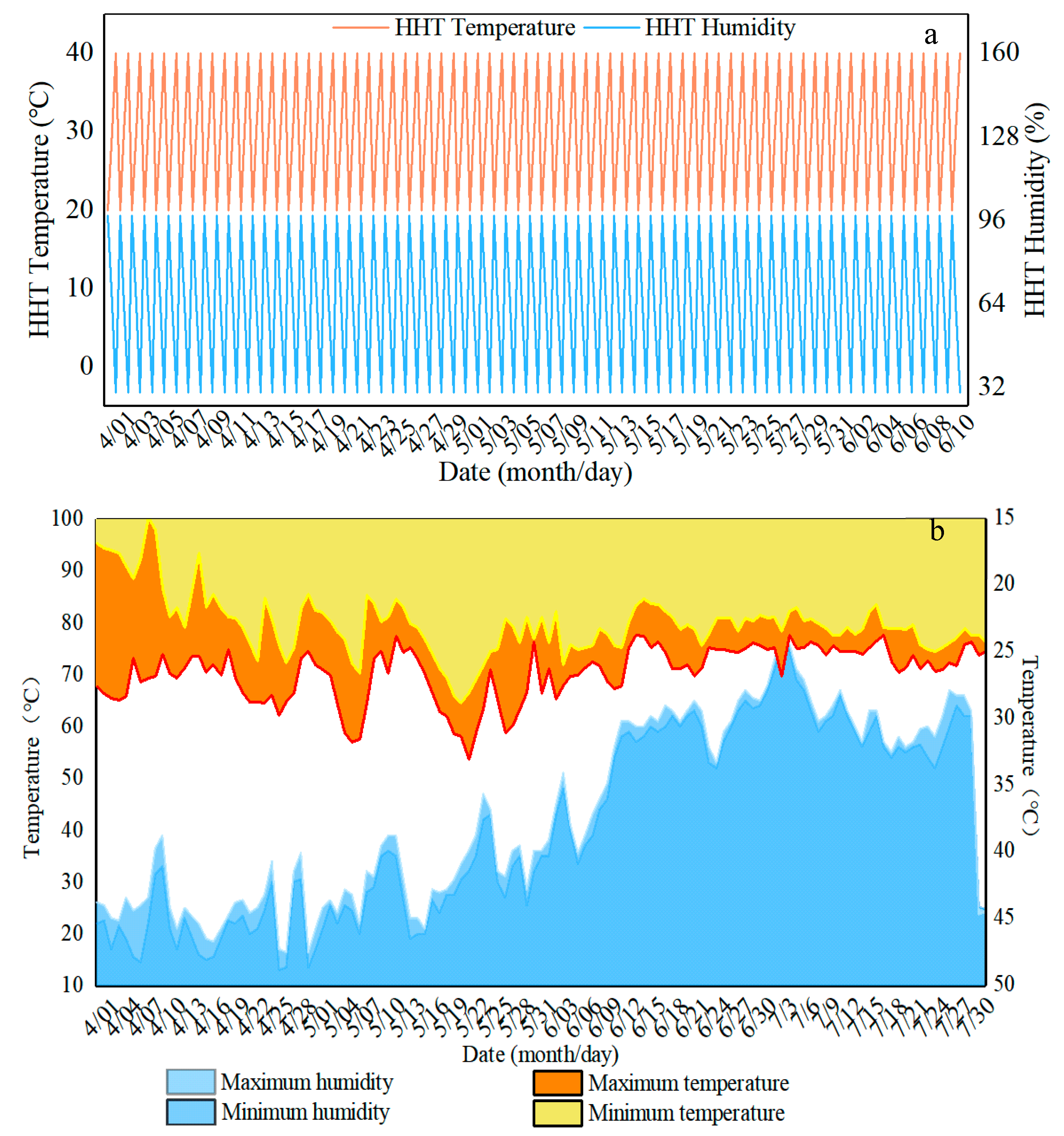
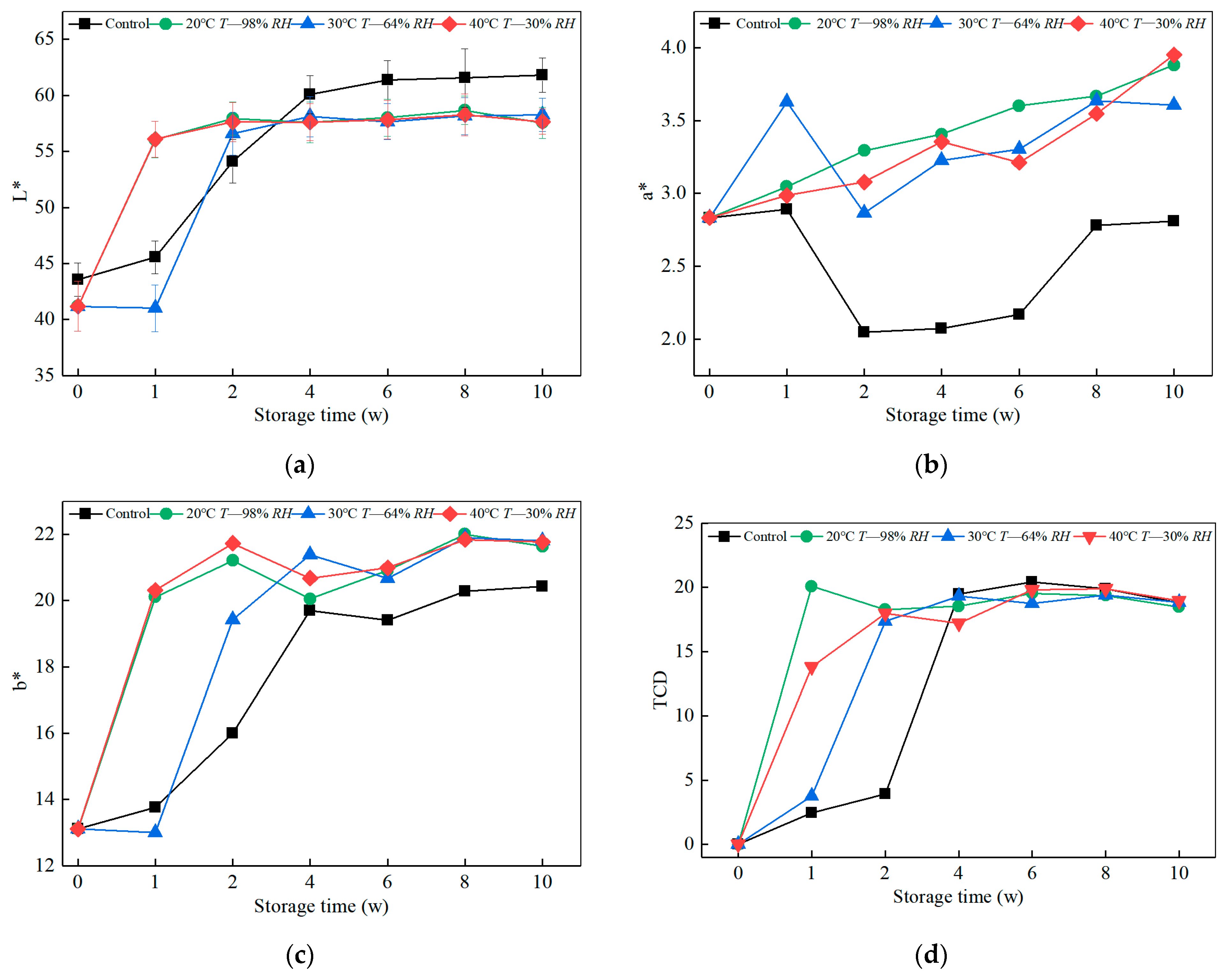
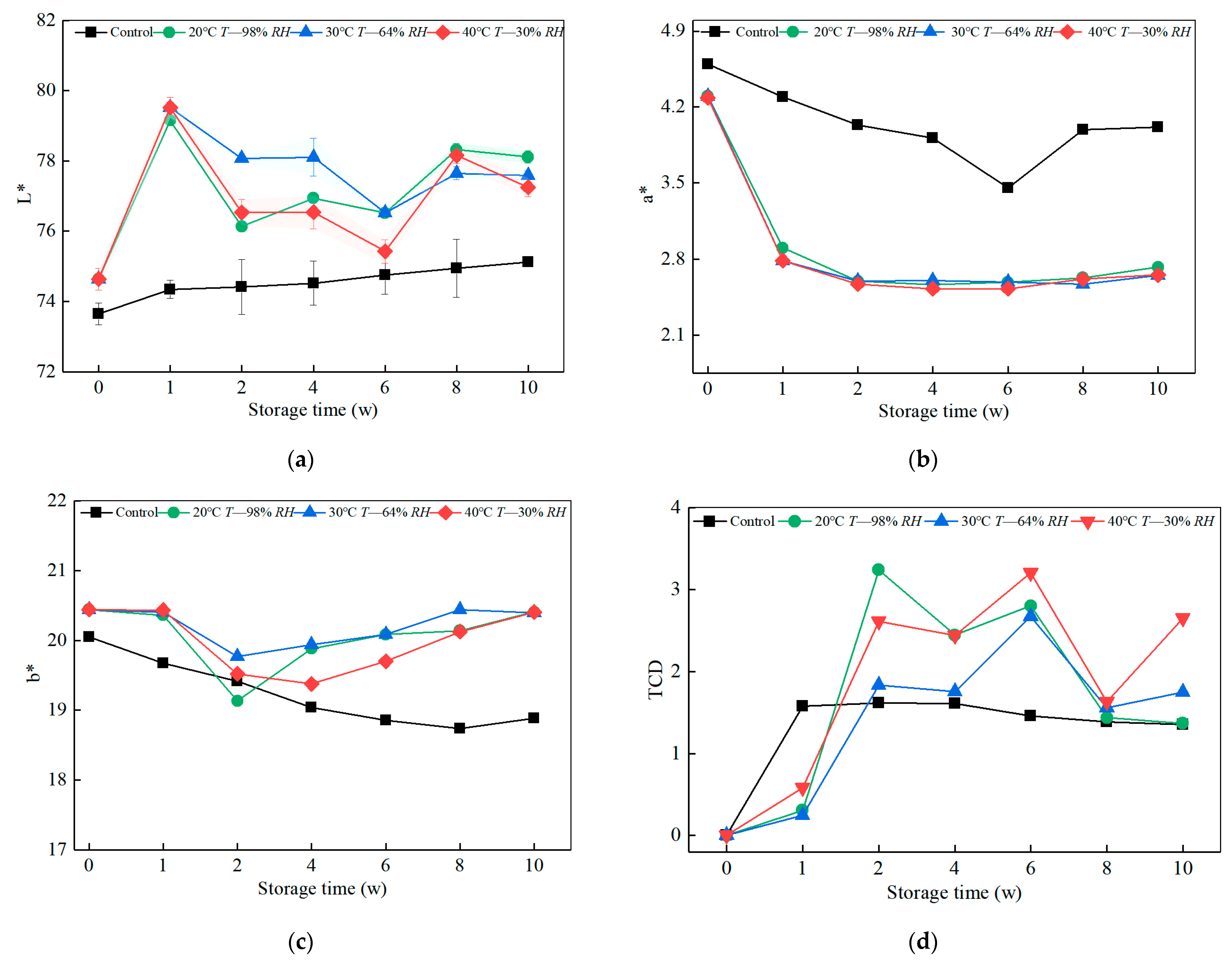
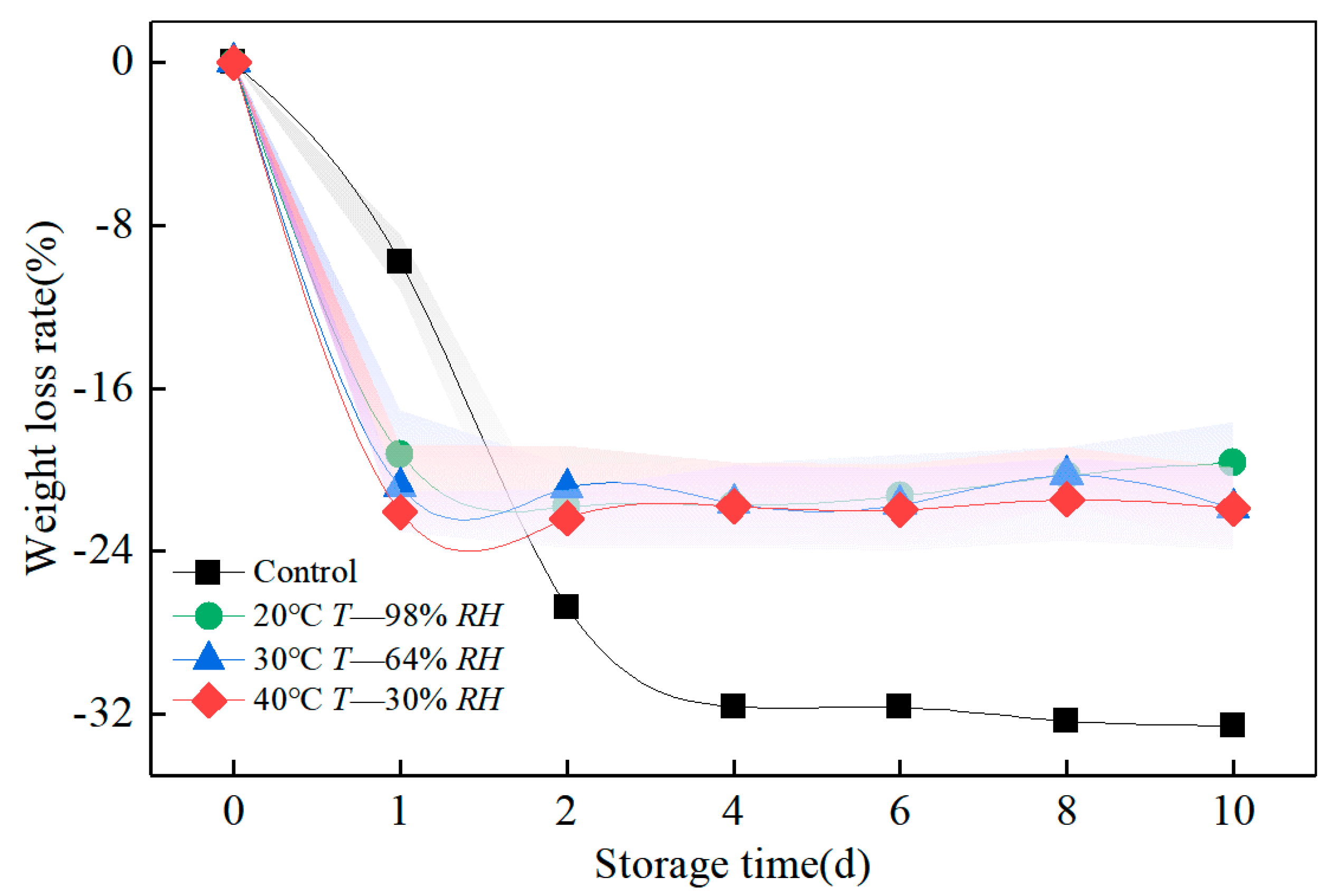
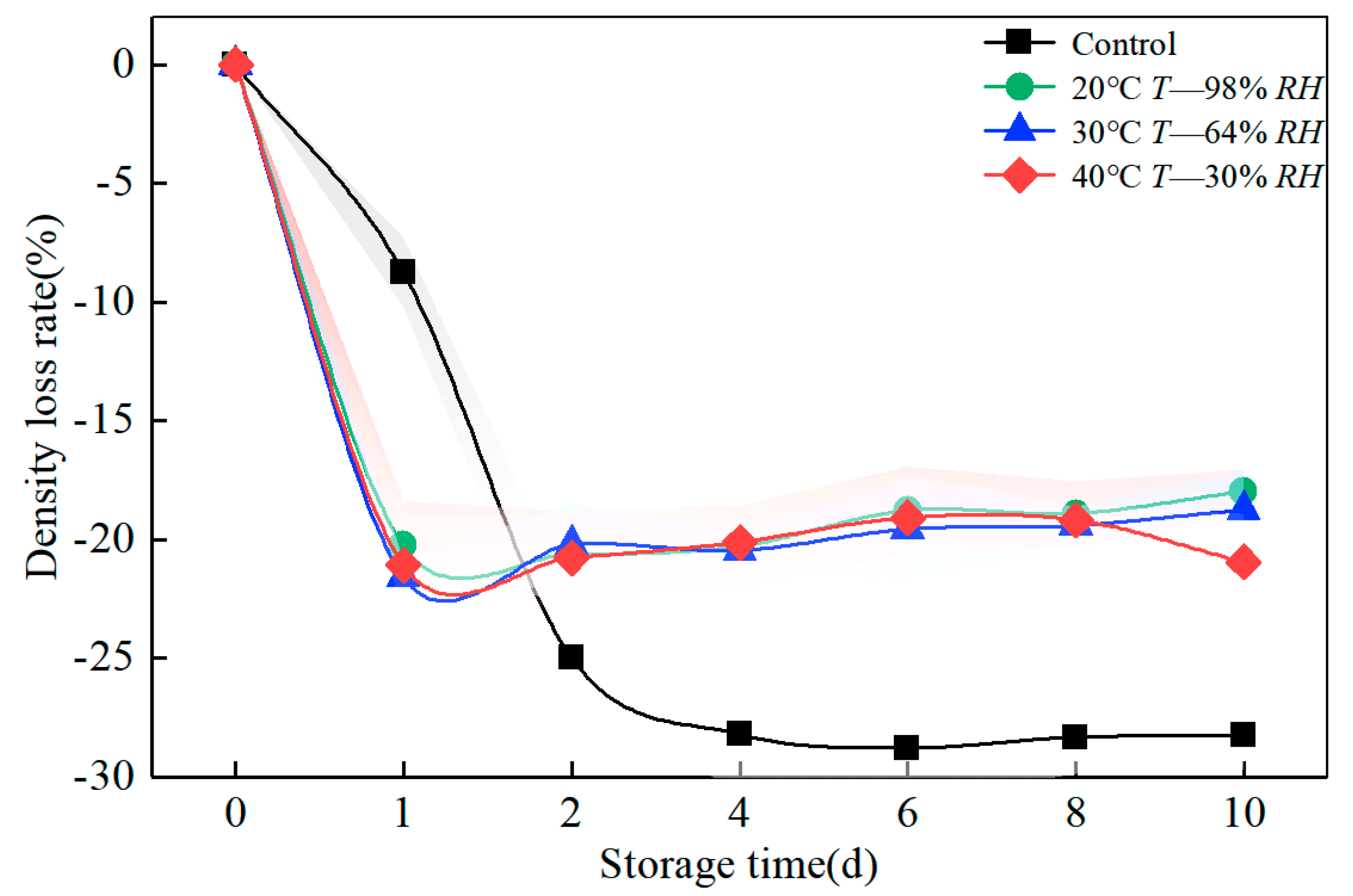
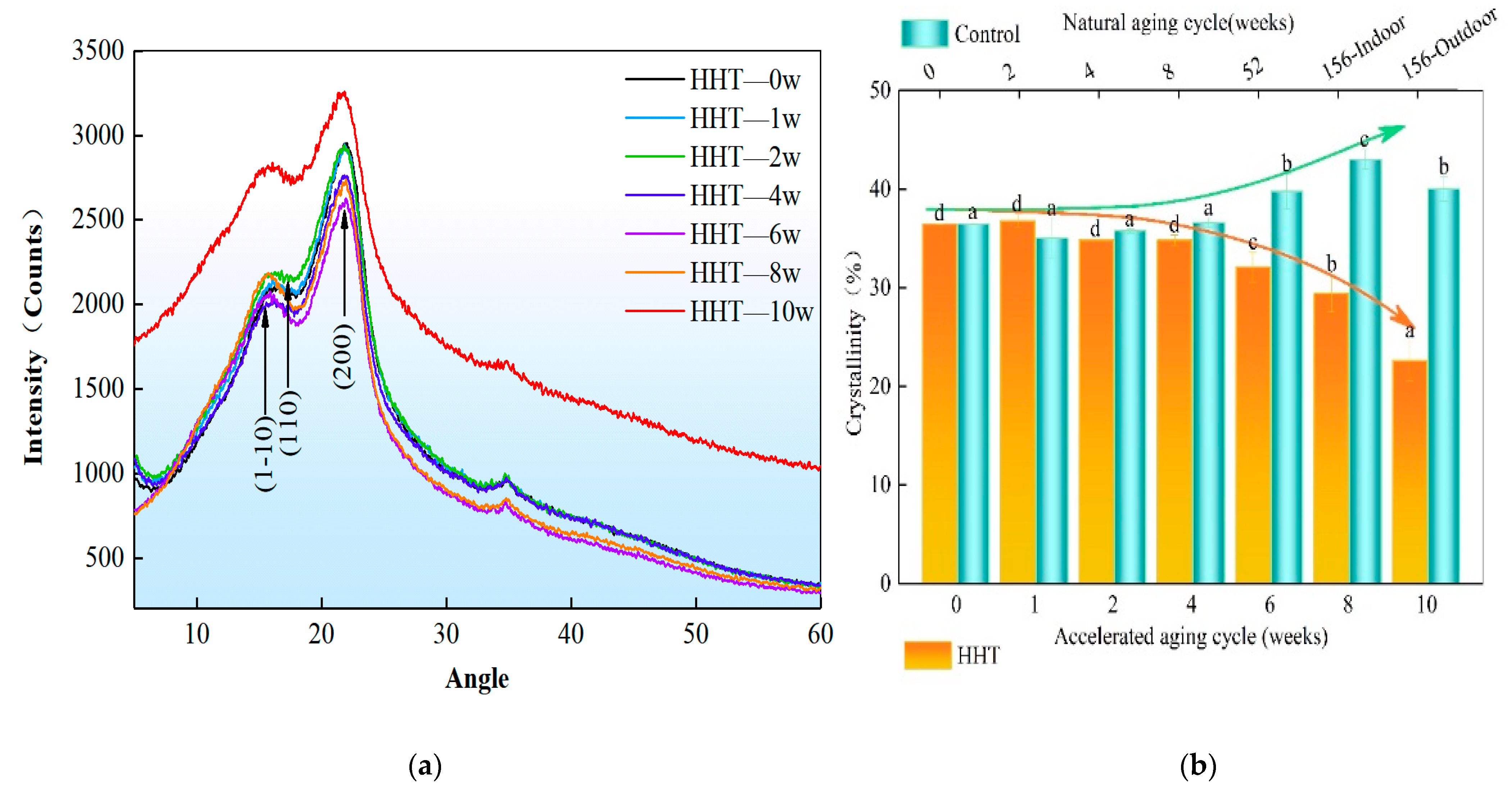
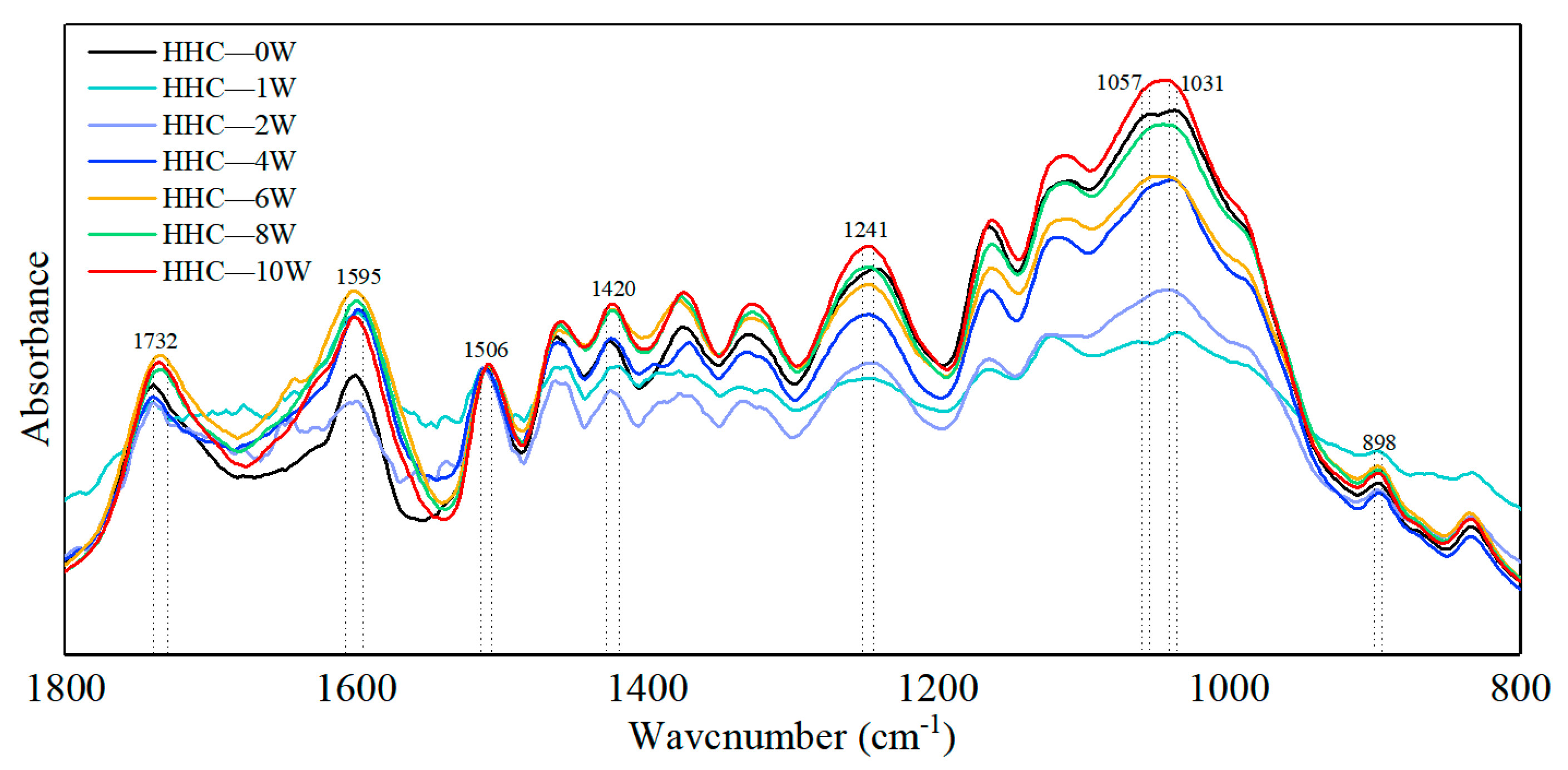


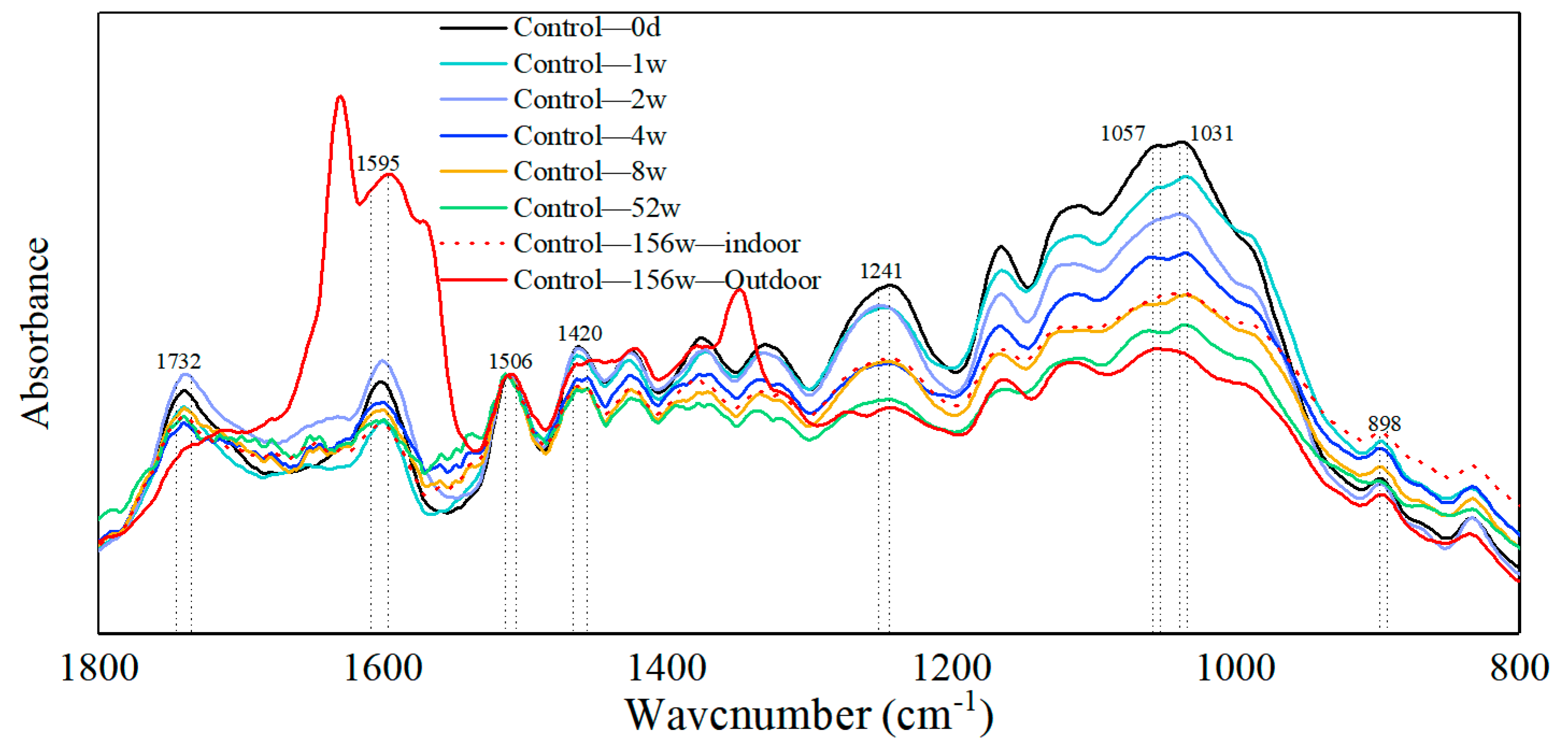
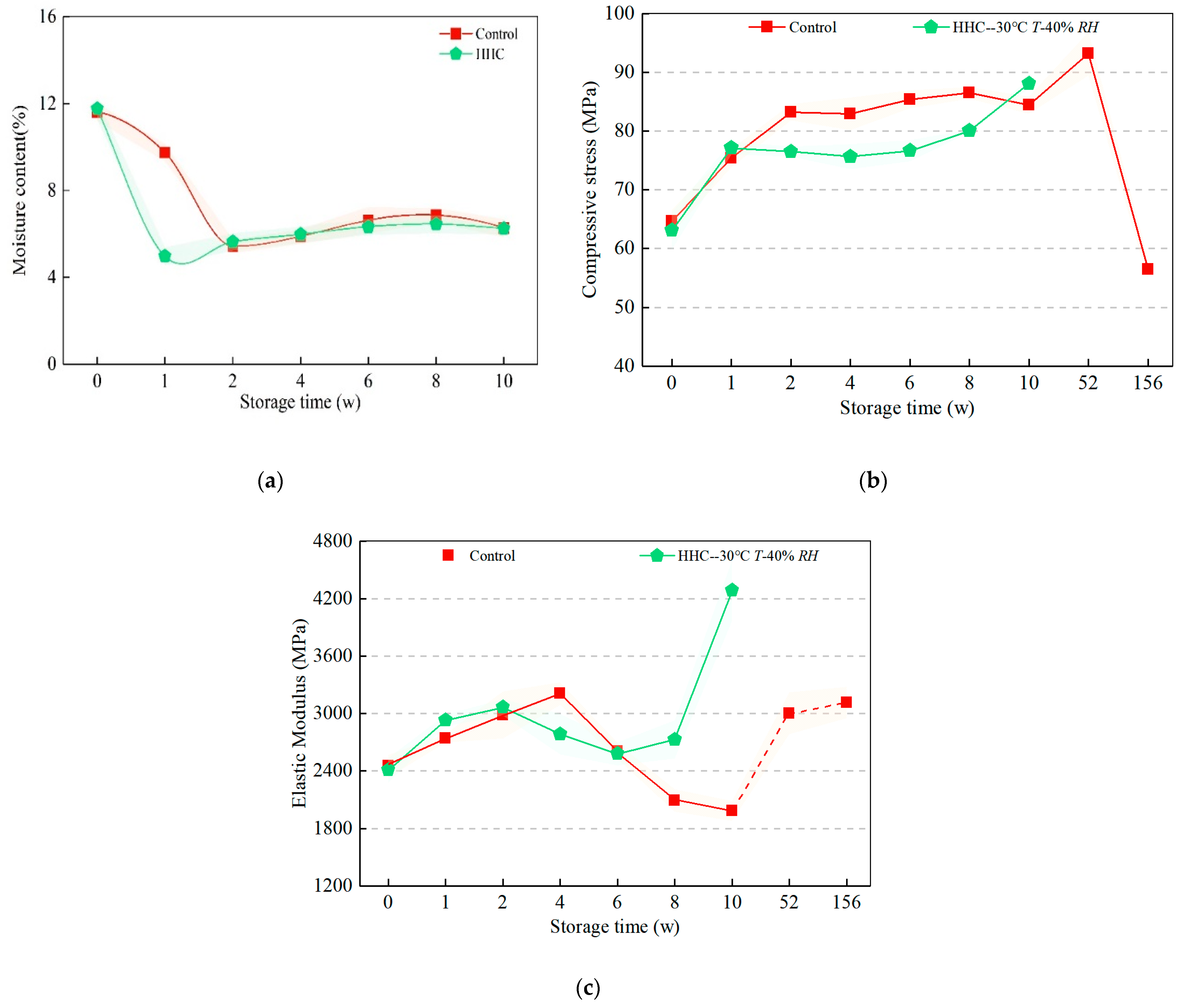
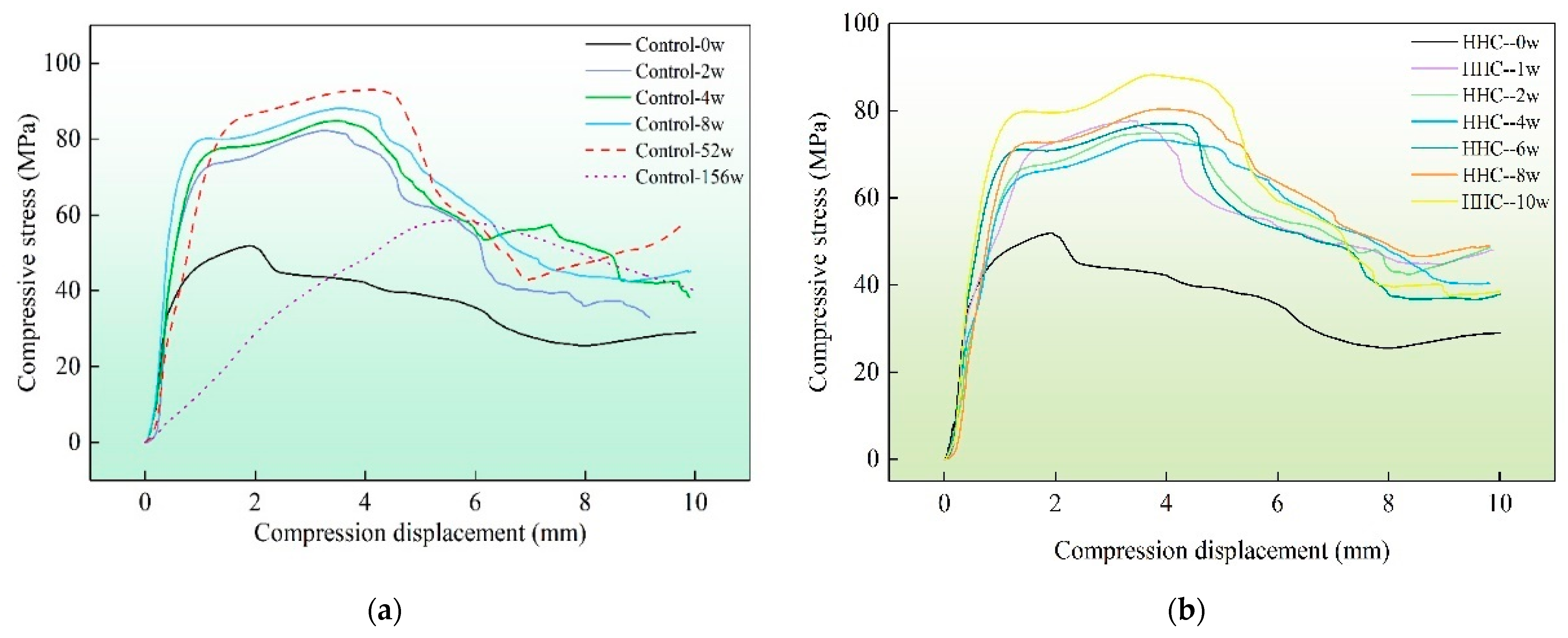
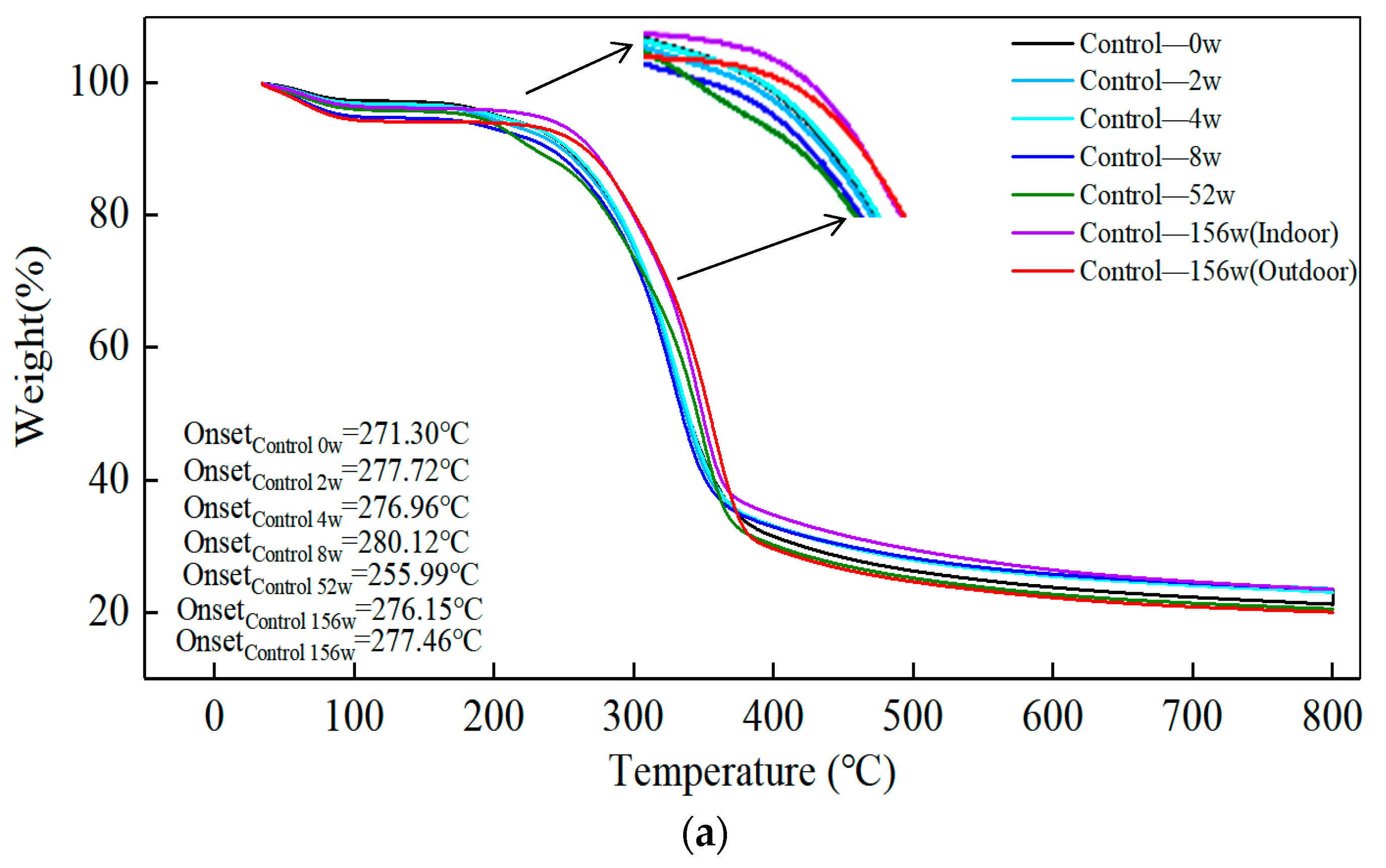
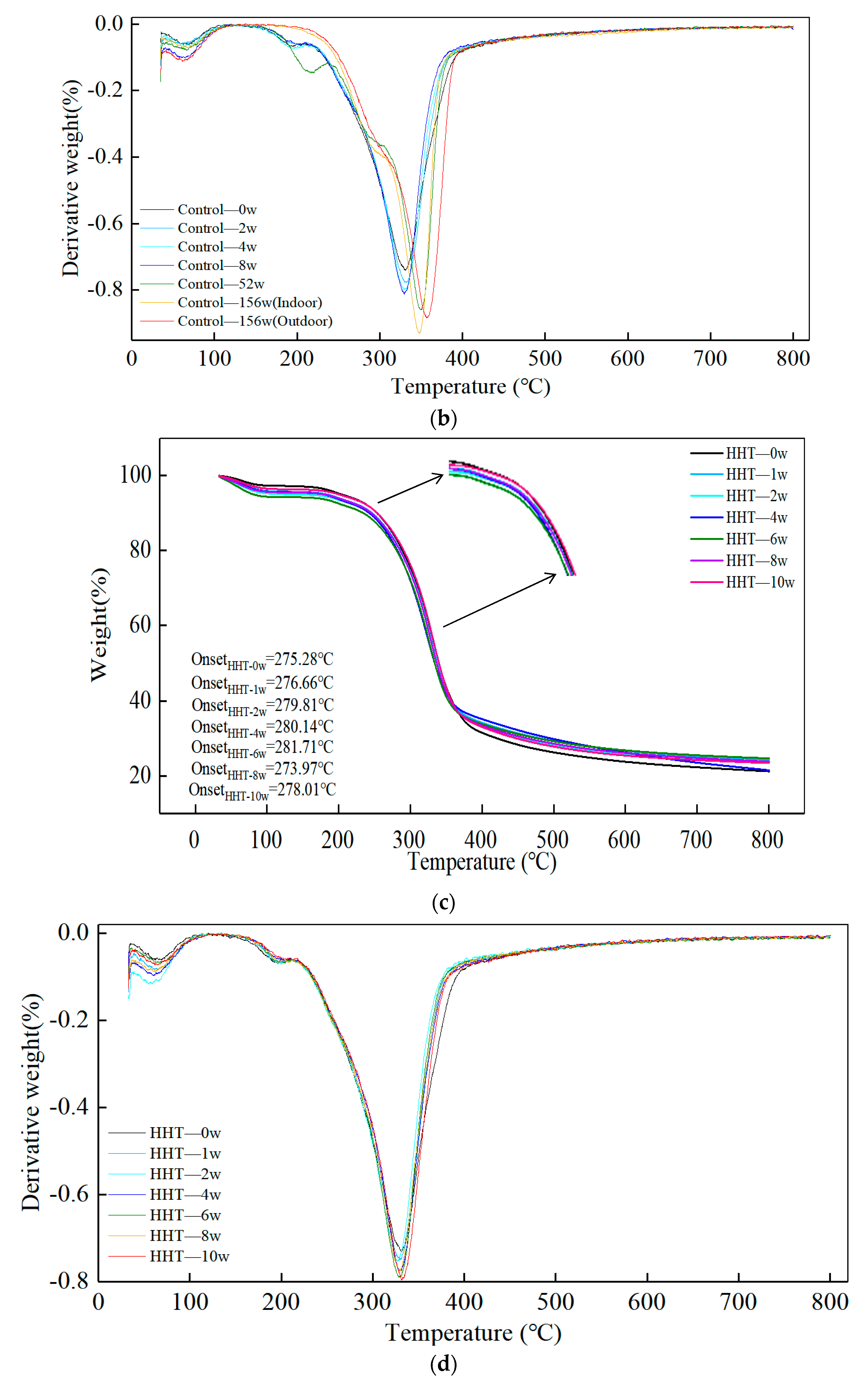
| Treatment | Dimensions (L × W × H)/mm | 30 °C T-64% RH/g | 40 °C T-30% RH/g | 20 °C T-98% RH/g | Control/g | |
|---|---|---|---|---|---|---|
| Ageing Cycle (Weeks) | ||||||
| 0 | 39.65 × 21.45 × 13.60 | 9.93 ± 0.277 | 9.93 ± 0.277 | 9.93 ± 0.277 | 8.92 ± 0.422 | |
| 1 | 39.56 × 21.51 × 13.57 | 7.86 ± 0.269 | 7.82 ± 0.267 | 8.02 ± 0.264 | 6.52 ± 0.279 | |
| 2 | 39.44 × 21.03 × 14.59 | 7.85 ± 0.263 | 7.75 ± 0.259 | 7.76 ± 0.256 | 6.24 ± 0.233 | |
| 4 | 39.31 × 22.77 × 13.58 | 7.78 ± 0.256 | 7.76 ± 0.257 | 7.77 ± 0.257 | 6.15 ± 0.224 | |
| 6 | 38.96 × 20.81 × 13.42 | 7.77 ± 0.256 | 7.75 ± 0.256 | 7.81 ± 0.259 | 6.18 ± 0.158 | |
| 8 | 38.89 × 20.92 × 13.42 | 7.91 ± 0.450 | 7.91 ± 0.480 | 7.75 ± 0.256 | 6.20 ± 0.219 | |
| 10 | 38.76 × 20.92 × 13.57 | 7.75 ± 0.256 | 7.98 ± 0.258 | 7.75 ± 0.256 | 6.18 ± 0.217 | |
| Treatment | Weight/g | Volume/cm2 | 30 °C T-64% RH | 40 °C T-30% RH | 20 °C T-98% RH | Control | |
|---|---|---|---|---|---|---|---|
| Ageing Cycle (Weeks) | |||||||
| 0 | 9.626 | 11.717 | 0.848 ± 0.022 | 0.847 ± 0.022 | 0.847 ± 0.022 | 0.914 ± 0.025 | |
| 1 | 7.855 | 11.747 | 0.669 ± 0.014 | 0.668 ± 0.015 | 0.675 ± 0.012 | 0.885 ± 0.015 | |
| 2 | 7.852 | 11.621 | 0.676 ± 0.013 | 0.671 ± 0.012 | 0.672 ± 0.013 | 0.745 ± 0.233 | |
| 4 | 7.778 | 11.473 | 0.678 ± 0.014 | 0.677 ± 0.014 | 0.675 ± 0.013 | 0.708 ± 0.020 | |
| 6 | 7.768 | 11.305 | 0.687 ± 0.015 | 0.700 ± 0.021 | 0.688 ± 0.012 | 0.704 ± 0.018 | |
| 8 | 7.912 | 11.388 | 0.694 ± 0.019 | 7.91 ± 0.480 | 7.75 ± 0.256 | 0.708 ± 0.018 | |
| 10 | 7.753 | 11.381 | 0.681 ± 0.015 | 7.98 ± 0.258 | 7.75 ± 0.256 | 0.705 ± 0.012 | |
| Group Category | Accelerated Aging Treatment Group | Natural Aging Control Group | ||||||||||
|---|---|---|---|---|---|---|---|---|---|---|---|---|
| Quadratic Sum | df | Mean Square | F | Signficance | Quadratic Sum | df | Mean Square | F | Signficance | |||
| Inter-group | Combination | 457.021 | 6 | 76.17 | 50.446 | 0 | 151.119 | 6 | 25.186 | 17.247 | 0 | |
| Linear term | contrast | 373.557 | 1 | 373.557 | 247.401 | 0 | 100.477 | 1 | 100.477 | 68.805 | 0 | |
| deviation | 83.464 | 5 | 16.693 | 11.055 | 0 | 50.642 | 5 | 10.128 | 6.936 | 0.002 | ||
| Intra-group | 21.139 | 14 | 1.51 | 20.444 | 14 | 1.46 | ||||||
| Total | 478.16 | 20 | 171.563 | 20 | ||||||||
| Accelerated Aging Treatment Group | Natural Aging Control Group | |||||||||||
|---|---|---|---|---|---|---|---|---|---|---|---|---|
| Sample Number | Number of Cases | Subset of Alpha = 0.05 | Sample Number | Number of Cases | Subset of Alpha = 0.05 | |||||||
| Aging Period (Weeks) | 1 | 2 | 3 | 4 | Aging Period (Weeks) | 1 | 2 | 3 | ||||
| Duncan’ a | 10 | 3 | 22.6381 | Duncan’ a | 2 | 3 | 35.0346 | |||||
| 8 | 3 | 29.409 | 3 | 3 | 35.761 | |||||||
| 6 | 3 | 32.0932 | 1 | 3 | 36.4589 | |||||||
| 4 | 3 | 34.8435 | 4 | 3 | 36.6047 | |||||||
| 2 | 3 | 34.8734 | 5 | 3 | 39.7758 | |||||||
| 0 | 3 | 36.4589 | 7 | 3 | 40.0109 | |||||||
| 1 | 3 | 36.8112 | 6 | 3 | 43.0109 | |||||||
| Significance | 1 | 1 | 1 | 0.091 | Significance | 0.163 | 0.815 | 1 | ||||
| Wavcnumber (cm−1) | Vibration | Funcalities | Component | References |
|---|---|---|---|---|
| 898 | C–H deformation | — | cellulose | [28,33] |
| 1031 | C-O stretching | Phenolic moieties | Lignin | [34] |
| 1057 | C–O stretch | — | Cellulose and hemicellulose | [35] |
| 1241 | C–O–C stretching | Syringyl ring | Lignin | [33] |
| 1420 | –(Ar) C=C stretching | Aromatic moieties | Lignin | [34] |
| 1506 | aromatic skeletal vibration | Aromatic ring | Lignin | [35] |
| 1595 | –(Ar)C=C | Aromatic skeletal vibration | Lignin | [33] |
| 1732 | –(H)C=O stretching | Aldehydic carbonyl groups | Hemicellulose (xylan) | [35] |
Publisher’s Note: MDPI stays neutral with regard to jurisdictional claims in published maps and institutional affiliations. |
© 2022 by the authors. Licensee MDPI, Basel, Switzerland. This article is an open access article distributed under the terms and conditions of the Creative Commons Attribution (CC BY) license (https://creativecommons.org/licenses/by/4.0/).
Share and Cite
Jia, H.; Chen, L.; Fei, B.; Sun, F.; Fang, C. Effects of Accelerated Ageing by Humidity and Heat Cycles on the Quality of Bamboo. Polymers 2022, 14, 4052. https://doi.org/10.3390/polym14194052
Jia H, Chen L, Fei B, Sun F, Fang C. Effects of Accelerated Ageing by Humidity and Heat Cycles on the Quality of Bamboo. Polymers. 2022; 14(19):4052. https://doi.org/10.3390/polym14194052
Chicago/Turabian StyleJia, Hao, Lei Chen, Benhua Fei, Fengbo Sun, and Changhua Fang. 2022. "Effects of Accelerated Ageing by Humidity and Heat Cycles on the Quality of Bamboo" Polymers 14, no. 19: 4052. https://doi.org/10.3390/polym14194052
APA StyleJia, H., Chen, L., Fei, B., Sun, F., & Fang, C. (2022). Effects of Accelerated Ageing by Humidity and Heat Cycles on the Quality of Bamboo. Polymers, 14(19), 4052. https://doi.org/10.3390/polym14194052






